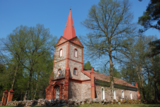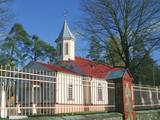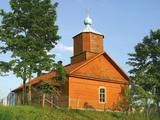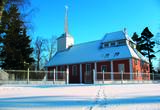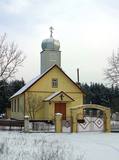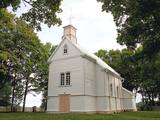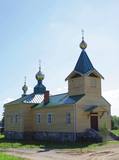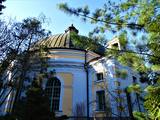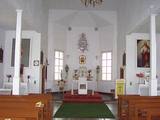| Nr | Name | Beschreibung |
|---|---|---|
|
Atrodas Pļaviņu HES ūdenskrātuves krastā (R. Blaumaņa ielas galā) iepretim salai, uz kuras top Likteņdārzs. Baznīca (celta 1687. g.) ir vairākkārt atjaunota (1731., 1887.). Tagad redzamais tornis tapis par Stukmaņu muižas īpašnieku atvēlētajiem līdzekļiem. Baznīcā par mācītāju kalpojis Ernests Gliks. Padomju laikos ēkā atradies Stučkas vēstures un mākslas muzejs. Apmeklētāji var uzkāpt dievnama tornī (čuguna zvans!), kā arī aplūkot mākslinieka A. Dobenberga gleznas. Baznīca ir atvērta un apskatāma arī no iekšpuses. |
||
|
A bit less than one kilometre from the Aizkraukle castle hill, the church can be seen from the Rīga-Daugavpils highway (A6). The church was built in 1688 on the steep banks of the
|
||
|
Iespaidīga koka celtne un izcils koka arhitektūras piemērs, kuru pamanīs katrs Plateļu apmeklētājs! Plateļu baznīca ir viens no Lietuvas vecākajiem koka dievnamiem. Pašreiz redzamais ir būvēts 1744. g., bet zvanu tornis – 1899. g. Dienvidos no baznīcas plešas Plateļu muižas parks. |
||
|
The church was built in 1835, and its greatest treasure is the organ, which was built by Karl Bittner in 1854. The manse is being restored. Boats are available for rental. |
||
|
Находится в 2,5 км к северу от Круте. Небольшое здание из деревянных бревен с дощатой обшивкой первоначально было построено в 1642 году, а кирпичная башня восстановлена после Второй мировой войны. Интерьер церкви – алтарь (вторая половина XVII века), алтарная икона неизвестного автора «Иисус у креста» (XVII в.) и богато орнаментированная кафедра (1642 г.) являются важными памятниками времен маньеризма. |
||
|
Die heutige Kirche aus Holz wurde auf diesem Hügel im Jahr 1947 gebaut, aber sie ist erneuert worden. Heute befindet sich in der Kirche das Dekanat von Rēzekne. Die Kirche kann man von außen besichtigen. Im Dorf Dukstigals waren bis zum Jahr 1960 zwei Gemeinden: Das Weiße Dukstigals (von Šadurskis) und das Schwarze Dukstigals (von Slobodskis). Im Weißen Dukstigals wurde eine Kirche im Jahr 1775 gebaut. Diese Kirche hat die Sowjetmacht im Jahr 1960 gewalttätig zerstört. Und das wurde trotz der Tatsache gemacht, dass diese Kirche ein Baudenkmal und die älteste Kirche (367 Jahre alt) in der Region Latgale war! Eine Rechtfertigung war die Erklärung, dass sich in einer Gemeinde zwei Kirchen nicht befinden dürfen. |
||
|
St. Cross Honouring Roman Catholic Church of Malta (Rozentova) is national architectural
monument. The church has a promiment „St. Mary Magdalene beside the Cross of Jesus” and three big
altars. The wooden log building was constructed in 1780. It was sanctified in 1782.
|
||
|
Atrodas Grobiņas centrā, Dzērves laukuma malā. Pirmā baznīca Grobiņa bija celta jau ap 1560. g., bet nākamā – 1596. g. celtā iznīcināta 1659. g. zviedru iebrukuma laikā. Pēc Kurzemes un Zemgales hercoga Jēkaba Ketlera iniciatīvas 1664. g. tiek uzcelts jauns dievnams, ko atjauno 1892. gadā. Tas dedzis 2. pasaules kara laikā, bet vēlāk atkal atjaunots. Šobrīd notiek altāra restaurācijas darbi. |
||
|
Lipuški Old-Believers Prayer House was built in 1893 at lake
Rāzna in village Lipuški. In former days, it was one of the largest Old-
Believers parishes in the Baltic countries; you will notice Old-Believers cemeteries that are placed in the
neighbourhood.
|
||
|
Целостное здание церкви строилось в 1780 – 1781 гг. во времена барона Х.Ф. Бера, а перестраивалось в 1876 и 1888 гг. Церковь известна своим алтарем и кафедрой, выполненными в стиле рококо, и построенным в первой половине XVIII века органом. Церковь можно осмотреть изнутри. |
||
|
Roman Catholic Church of Divine Grace – On 19 April 1998, the so-called “White Sunday” or the Day of Divine Grace, Saulkrasti Roman Catholic Church of Divine Grace was consecrated. The building is 24 m long and its tower is 16 m high. The 300-seat church was designed by the architect Jānis Šrēders. The image of Christ on the altarpiece was derived from the vision of the saint, Sister Faustina, of 22 February 1931 in a monastery in Poland. The altarpiece was created by the artist Ēriks Pudzēns. 14 paintings on the walls of the church depict Christ’s path of suffering from conviction to resurrection. The altar is built of ash. On 2 August 1998, a 7.38 m tall cross was consecrated by Saulkrasti Roman Catholic Church of Divine Grace. At night this cross is illuminated. The cross is similar to the cross of Golgotha in Jerusalem where Jesus Christ was crucified. |
||
|
Atrodas Ēdoles centrā. Dievnams tapis 17. gs. vidū, pateicoties Ēdoles pils īpašnieka - Johana Dītriha Bēra iniciatīvai, kas to veltījis sava noslepkavotā tēva piemiņai, domādams, ka tādējādi varēs izpirkt brāļa Filipa - tēva slepkavas grēkus. Lai izpirktu savējos, J. D. Bērs licis sevi paglabāt zem baznīcas durvju sliekšņa. Dievnama iekštelpas rotā sākotnējais baroka interjers, kā arī krāšņs ērģeļu prospekts un luktu apdares elementi. |
||
|
Malta (Borovaja, Borovska) Old-Believers Prayer House. The construction
of the church was started in 1931 by A. Gruncevičs. The Church is an architectural
monument of local importance.
|
||
|
Die Kirche befindet sich an dem nordöstlichen Ufer des Sees Mazais Subates ezers. Das Gotteshaus ist von 1685 bis 1686 im byzantinischen Stil laut der Anweisung des Besitzers des Landgutes von Prode H. F. Osten-Sacken gebaut worden. Diese Kirche ist die einzige Kirche in Lettland, deren Architektur den Formen eines idealen protestantischen Gotteshauses aus dem Ende des 17. Jhs. ähneln, Interessant sind die kleinen Türme an den Gebäudeecken. Die Innenausstattung des Gotteshauses bilden reichlich ornamentierte und mit Skulpturen verzierte Holzschnitzereien, darunter auch der Altar aus dem 17. Jh., die Kanzel und die Beichtbank, sowie Kunstwerke aus dem 17. bis 18. Jh. und eine im Jahr 1682 gegossene Glocke. Es ist noch zu erwähnen, dass einen Teil der Innenausstattung der Kirche die Handwerker der Holzbildbauerschule aus Stelmuže hergestellt haben. |
||
|
Roman Catolic Church of Puša was built in 1743. Financed by Count Šadurskis; managed by Jesuits
mission. There is on organ and 3 altars in the church.
|
||
|
Mūsdienās redzamo (pēc skaita – trešo) baznīcu cēla laikā no 1835. - 1837. g. (ampīra stilā) Mārča Sāruma vadībā. Arī šīs ēkas projektēšanā par paraugu bija ņemts Pievolgas vācu baznīcu veidols, tādēļ tā līdzīga Dzērbenes luterāņu baznīcai. Dievnama altāri rotā Otto Donnera fon Rihtera glezna “Kristus debesbraukšana” (1898. g.). E. Martina firmā būvētās 10 reģistru ērģeles (1901. g.) darbojās arī šodien. Pie Drustu baznīcas atrodas 1932. g. atklātais un formās iespaidīgais (E. Kuraua firmas veidots) granīta piemineklis 1. pasaules karā un Latvijas Brīvības cīņās kritušo piemiņai. Nelielā baznīcas sienas nišā novietota piemiņas plāksne komunisma terora upuriem. |
||
|
Tiskādi Orthodox Church is the cultural monument of the local significance. The construction works of the building lasted from 1829 to 1878. The
church was reconstructed in 2008. The church has antique icons and the library
of sacred literature.
|
||
|
Nach Angaben befand sich die Kirche an dieser Stelle schon im 17. Jahrhundert. Die jetzige Kirche wurde von 1792 bis 1794 gebaut. Der Autor des Projektes eines kuppelförmigen Gebäudes war Christoph Haberland, der Hauptbaumeister von Riga. Eine Form der Kuppel sichert eine gute Akustik in den Innenräumen. Der Altar ist gegenüber der Eingangstür eingerichtet. Zwischen den Kolonnen des Gebäudes befindet sich ein Altarbild, das Christus und St. Peter in aufgewühltem Meer darstellt. Zu den bedeutenden Gegenständen der Innenausstattung gehören Weinbecher, Kerzenträger aus den 18 – 19 Jahrhunderten u.a. 2014 wurde das Gebäude restauriert. Südlich von der Kirche befindet sich der Friedhof von Katlakalns, auf dem ein berühmter deutsch-baltischer Publizist und Schriftsteller Garlieb Merkel (1769 – 1850) bestattet wurde, der eine große Rolle in der Aufhebung der Leibeigenschaft im Baltikum spielte. |
||
|
Located in the
|
||
|
Holy Trinity Parish Catholic Church of Strūžāni was renovated
and sanctified in 1958. The church has no towers because they were not allowed in the time of the Soviet
Union.
|
||

